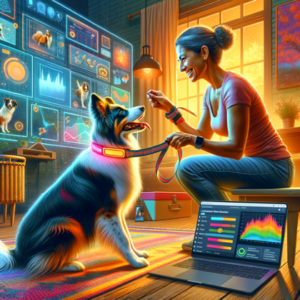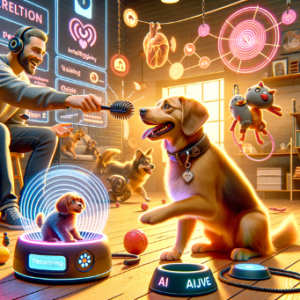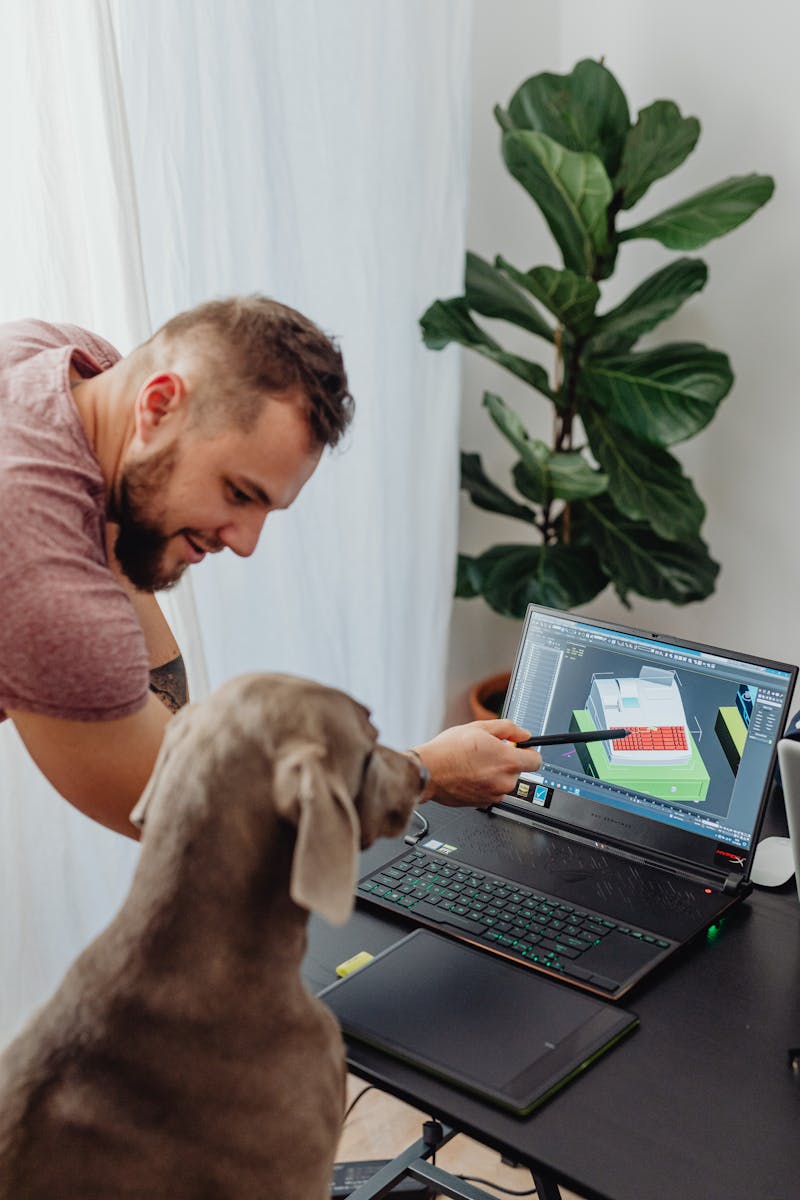Training for the Modern Day Pet: Incorporating Technology into Behavior Modification
The Importance of Technology in Dog Training
In our increasingly digital world, technology has seeped into every aspect of our lives — including the way we train our furry friends. Gone are the days when dog training relied solely on traditional methods such as verbal commands and physical cues. Today, technology plays a pivotal role in enhancing these methods, providing dog owners with effective tools that make training more efficient and engaging. In this article, we’ll explore how technology can transform the dog training landscape and support both trainers and pet owners on their journey.
Understanding the Role of Technology in Dog Training
Technology offers various tools and resources that can complement traditional training methods. Below are some key ways in which technology enhances dog training:
1. Smart Collars and Wearables
- Real-Time Monitoring: Smart collars equipped with GPS tracking and activity monitoring allow pet owners to track their dog’s behavior and activity levels.
- Behavioral Analysis: Devices that measure barking frequency or analyze body language provide insights into your dog’s emotional state, facilitating a more tailored training approach.
- Remote Training Features: Many smart collars come with remote training capabilities, allowing you to deliver commands or feedback even if you’re not physically present.
2. Training Apps
- Interactive Training Programs: Several mobile applications offer interactive training programs with step-by-step guidance, making it easier for dog owners to follow through with their training.
- Progress Tracking: With built-in features that track training progress, pet owners can easily monitor their dog’s learning journey and make adjustments as needed.
- Online Communities: Many apps have community forums that allow dog owners to connect with others, share experiences, and seek advice on specific training challenges.
3. Online Training Courses and Resources
- Expert Guidance: Access to online courses created by professional trainers offers valuable insights into effective training techniques and theories.
- Video Tutorials: Engaging video tutorials simplify complex commands and training exercises, making it easier for owners to understand how to teach their dogs effectively.
- Accessibility: With online resources, pet owners can learn at their own pace and revisit materials whenever needed, accommodating different schedules and learning styles.
4. Interactive Toys and Gadgets
- Cognitive Enrichment: Technologically advanced toys designed to stimulate a dog’s intellect can keep them engaged and aid in the training process by encouraging problem-solving skills.
- Reward-Based Training: Toys that dispense treats can be a great addition to reward-based training methods, reinforcing good behavior while making learning fun.
- Remote Play: Gadgets equipped with cameras and treat dispensers allow for remote interaction, enabling pet owners to engage with their dogs during busy schedules.
5. Virtual Reality and Augmented Reality
- Simulated Environments: Virtual reality (VR) can create environments for dogs to acclimatize to new experiences (like sound desensitization) in a controlled manner.
- Augmented Feedback: Augmented reality (AR) applications can overlay training cues in real-time, allowing users to visualize proper techniques and commands during training sessions.
Actionable Tips for Harnessing Technology in Dog Training
To incorporate technology successfully into your dog’s training, consider the following tips:
- Choose the Right Devices: Whether opting for a smart collar or an interactive toy, select devices that suit your dog’s specific needs and learning style.
- Set Clear Goals: Identify what behaviors or commands you want to work on and outline measurable objectives. Track progress using apps or digital tools to stay motivated.
- Stay Consistent: Consistency is crucial in dog training, especially when combining traditional methods with technology. Ensure that everyone involved in your dog’s training is on the same page.
- Engage Regularly: Use technology to facilitate regular interactions and training sessions, such as virtual classes or app notifications that remind you to practice.
- Monitor Feedback: Leverage the data provided by your devices to assess your dog’s progress, making adjustments to your training plan as necessary based on their performance.
Conclusion: Embrace the Future of Dog Training
Incorporating technology into dog training not only enhances traditional methods but also opens new avenues for effective learning and engagement. From smart collars that provide real-time feedback to interactive apps and online resources that guide you through the training process, technology is redefining how we train our beloved pets.
By staying informed and leveraging these tools, dog owners can create customized training experiences that yield positive results and strengthen their bond with their furry companions. As the world of dog training continues to evolve, embracing these advancements can make the training process not only more effective but also more enjoyable.

Types of Training Devices
With the integration of technology in dog training, various tools have emerged to assist in teaching our canine companions more effectively. Here’s a closer look at some of the most popular and effective training devices available today.
1. E-Collars (Electronic Collars)
- Remote Control Training: E-collars enable trainers to communicate with their dogs at a distance, allowing for correction and reinforcement without physical presence.
- Adjustable Stimulation Levels: Many e-collars come with varying stimulation settings, allowing for customized intensity to suit the dog’s sensitivity and training needs.
- Long-Distance Ranges: Ideal for off-leash training, e-collars can function over long distances, which is beneficial for dogs that need more space to learn and explore.
2. Smart Collars
- GPS Tracking: Smart collars equipped with GPS ensure that owners can track their pets’ locations, easing concerns about wandering or getting lost.
- Health Monitoring: Advanced smart collars can monitor a dog’s health metrics, such as heart rate and activity levels, providing insights that support training and overall well-being.
- Behavioral Correction Features: Some smart collars can issue alerts or corrections when the dog engages in undesired behaviors, helping to enforce commands effectively.
3. Treat Dispensers
- Timed Rewards: Automated treat dispensers enable owners to reward good behavior at strategic times, reinforcing positive actions without requiring immediate physical interaction.
- Interactive Training Sessions: Many dispensers can be controlled via smartphone apps, allowing for remote activation during training sessions, even when you’re not at home.
- Engagement Tools: Treat dispensers can help keep dogs engaged during training by making learning more interactive and fun, promoting a positive association with training activities.
4. Training Clickers and Apps
- Positive Reinforcement Training: Clickers are a simple technology used to mark desired behavior, making it clear to the dog what action is being rewarded.
- Mobile Apps for Tracking Progress: There are various dog training apps available that allow owners to log training sessions, track progress, and even set reminders to practice specific commands regularly.
- Community Engagement: Many training clicker apps connect users to online communities, offering shared insights and support as they navigate their training journeys.
5. Interactive Gadgets
- Puzzle Toys: These toys stimulate a dog’s mental faculties and serve as effective pre-training activities, helping to tire them out before a session.
- Automated Ball Launchers: These devices allow dogs to play fetch independently, promoting physical activity while incorporating training commands such as ‘fetch’ and ‘drop it.’
- Remote Training Devices: Devices like treat tossers and camera-equipped gadgets enable owners to train their dogs and give commands remotely, ensuring regular engagement even during a busy day.
6. Virtual Training Platforms
- Live Online Classes: Many dog trainers now offer virtual classes, providing real-time instruction and feedback tailored to individual dogs’ needs, accessible from the comfort of home.
- On-Demand Video Resources: There’s a wealth of video content available focusing on various training techniques, allowing owners to find resources that specifically address their dog’s behavioral issues.
- Social Media Groups: Platforms like Facebook and Instagram offer various groups where dog owners can share tips and experiences, creating a supportive community for ongoing learning.
Actionable Tips for Choosing the Right Technology
When exploring training devices, keep these actionable tips in mind:
- Research Before Buying: Look for reviews and recommendations from other users to ensure the device meets your training needs and your dog’s temperament.
- Trial and Error: Don’t hesitate to try different devices to determine which works best for you and your dog; what works for one may not suit another.
- Integrate Technology Gradually: Introduce new devices or apps gradually to avoid overwhelming your dog and to ensure they acclimate to each tool effectively.
- Evaluate Results Regularly: As you incorporate technology into training, regularly assess your dog’s progress to determine if adjustments are necessary for optimal results.
Conclusion: Embrace Technology for Enhanced Training
By leveraging the right technological tools, dog owners can elevate their training experience and foster a deeper connection with their pets. Each device offers unique features designed to facilitate learning and reinforce desirable behaviors. As you continue your dog training journey, consider these training devices to enhance your methods and improve outcomes.

Selecting the Right Technology: Tailoring Tools to Your Dog’s Breed, Age, and Needs
When it comes to dog training, not all technology tools are created equal. Selecting the right training tools based on your dog’s breed, age, and specific needs can help you achieve optimal results. Here’s a breakdown of how to choose the best technology for your furry companion.
1. Consider Your Dog’s Breed
- Understanding Behavioral Traits: Different breeds have unique behavioral traits and learning styles. For example, working breeds like Border Collies may benefit from smart collars that offer engaging training games, while toy breeds might respond better to treat-dispensing toys.
- Energy Levels: High-energy breeds such as Terriers and Retrievers thrive with interactive gadgets that stimulate both mind and body. Look for technologies that promote active engagement, like laser toys or smart collars with activity tracking.
- Sensitivity: Breeds known for their sensitivity, such as Greyhounds or Cavalier King Charles Spaniels, may require training tools with gentler feedback options, like vibration collars instead of shock collars.
2. Factor in Your Dog’s Age
- Puppies (0-1 Year): Young dogs are highly impressionable and need tools that cater to their energy and curiosity. Interactive toys and training apps designed for basic commands can establish foundational skills. Consider options like treat puzzles or bite-sized training courses to accommodate their shorter attention spans.
- Adult Dogs (1-7 Years): Adult dogs benefit from tools that challenge them mentally and physically. Smart collars that track activity can help ensure they get enough exercise. Online courses offering advanced training techniques can refine their skills and promote good behavior.
- Senior Dogs (7+ Years): For older dogs, choose technology that suits their physical and cognitive capabilities. Easy-to-use training apps, gentle interactive toys, or wearables that monitor health can offer support without overwhelming them.
3. Assess Your Dog’s Specific Needs
- Behavioral Issues: If your dog exhibits specific behavioral problems, like excessive barking, consider tools that provide real-time feedback such as smart collars that can alert you to undesirable behaviors. Video tutorials that focus on addressing these issues may also provide valuable insights.
- Dietary Considerations: For dogs that require a specific diet, look into treat-dispensing toys that can accommodate their dietary restrictions. Ensure that any technology you choose aligns with maintaining their health and well-being.
- Learning Preferences: Every dog has a unique learning style. Observe whether your dog prefers hands-on engagement, verbal cues, or visual aids. Training tools like apps with clicker training features might suit visual learners, while interactive toys can appeal to hands-on learners.
4. Explore Compatibility with Your Current Training Methods
- Integration with Traditional Training: Ensure that any technology you choose complements your existing training methods. If you’re using positive reinforcement, opt for treat-dispensing toys and apps that emphasize reward-based learning.
- Family Involvement: If multiple family members are involved in training, select apps or devices that offer multi-user support, ensuring consistent training methods across all handlers.
- Trial Periods: Many technology tools offer trial periods. Take advantage of these to evaluate how well the technology fits with your dog’s needs before committing to a purchase.
5. Budget Considerations
- Price Range: Technology can range from inexpensive training apps to high-end smart collars. Set a budget that allows for quality purchases without compromising on effectiveness.
- Long-Term Investment: Think of technology as a long-term investment in your dog’s well-being. High-quality tools may have a higher upfront cost but can save money on professional training services in the long run.
- Avenue for Discounts: Keep an eye out for discounts, especially when purchasing multiple tools or during special sales events, to maximize your budget.
Conclusion: Make Informed Choices for Your Dog’s Training Journey
By considering your dog’s breed, age, and specific needs, you can select the training technology that will not only enhance the learning experience but also foster a deeper connection between you and your furry friend.

Exploring Training Apps for Pet Owners
As we dive deeper into the role of technology in dog training, one of the most impactful tools available to pet owners is the myriad of training apps tailored specifically for optimizing the training experience. These applications not only allow dog owners to manage and track training schedules but also provide vital resources and tools for enhancing their efforts. Let’s explore some of the best training apps available and how they can make a difference in your dog’s training journey.
1. Popular Training Apps to Consider
- Pupford
-
- Features: Offers free video courses and a variety of training methods based on positive reinforcement techniques.
- Progress Tracking: Includes a progress tracker to help dog owners log their training sessions and milestones.
- Community Support: Has an active community where you can ask questions and share experiences with other dog owners.
- TrainAway
-
- Features: This app focuses on training and socializing your dog in different environments by offering GPS-based training routes.
- Goal Setting: Allows you to set specific training goals and tailor your experience based on your dog’s needs.
- Achievement Badges: Celebrates your dog’s accomplishments with badges to motivate continued training.
- Pawtner
-
- Features: Provides a training planner to schedule sessions and reminders to keep you on track with your training routine.
- Track Progress: Allows you to log sessions and behaviors, offering insights into your dog’s development and challenges.
- Resource Hub: Includes access to articles and videos that provide additional training tips and techniques.
2. Key Features to Look for in Dog Training Apps
When selecting a training app, it’s crucial to consider features that align with your training objectives. Below are some essential features to look for:
- User-Friendly Interface: Look for apps that are easy to navigate, allowing you to quickly schedule sessions and record progress.
- Step-by-Step Training Guides: Choose apps that provide clear instructions and video demonstrations for each command or behavior.
- Customization Options: Ensure the app offers personalized settings so you can modify the program to suit your dog’s learning pace and style.
- Social Integration: Apps that include forums or community connections can provide valuable support, allowing you to share tips and experiences with other pet owners.
- Data Analytics: Consider apps that offer insights and analytics about your dog’s training performance, helping you make informed adjustments as needed.
3. Integrating Apps into Your Training Routine
To maximize the benefits of training apps, here are several actionable tips for integrating them into your dog training routine:
- Set Aside Time for App Exploration: Dedicate initial time to explore the app’s features and understand how it works so that you can maximize its benefits.
- Engage with the Community: Participate in forums or discussions to ask questions and share your experiences, which can lead to increased motivation and support.
- Schedule Regular Updates: Regularly input your training data and review your dog’s progress to help keep training on track and make necessary adjustments accordingly.
- Use Reminders and Alerts: Take advantage of reminder features to stay consistent with training sessions, ensuring you’re actively engaging with your dog.
- Celebrate Small Wins: Use the app to log progress and celebrate achievements, no matter how small, to keep you and your dog motivated.
4. Real-World Example: The Impact of Apps on Training Success
One dog owner shared their experience using a popular training app. After adopting a rescue dog with behavioral issues, they utilized the app’s resources to create a tailored training schedule that addressed their dog’s specific challenges:
- Using the app, they logged training sessions, which helped them identify triggers for unwanted behaviors.
- They engaged with the community within the app, finding valuable tips from other owners who faced similar challenges.
- As a result of consistent tracking and community support, the owner not only saw marked improvement in their dog’s behavior but also strengthened their bond through effective communication during training sessions.
5. Staying Motivated with Technology
Maintaining motivation is crucial in dog training, and apps can play a supportive role. Here are a few strategies to help keep you and your dog motivated:
- Play Games: Use features that turn training sessions into games, making learning enjoyable for both you and your dog.
- Set Milestones: Break down training goals into smaller, achievable milestones to help maintain motivation throughout the training process.
- Document Progress with Media: Use the app to take photos or videos during training sessions, providing a visual reminder of how far you’ve come.
- Reward Yourself and Your Dog: Pair training success with rewards, ensuring the process remains positive and engaging.
By leveraging training apps, pet owners can navigate the complexities of dog training more effectively, create structured training routines, and foster engagement with their pets.
Conclusion
Embracing smartphone training apps allows pet owners to optimize their training schedules and keep track of progress, establishing a more productive training environment. Whether you are a first-time dog owner or an experienced trainer, technology can be a friendly ally in enhancing the way you connect with and train your dog.

The Benefits of Video Tutorials and Online Courses
When it comes to enhancing the learning experience for both pets and their owners, video tutorials and online courses are transforming the landscape of dog training. With immediate access to a wealth of information, more dynamic learning methods, and the ability to learn at one’s own pace, these digital resources are invaluable. Here are some of the key benefits:
1. Flexibility and Accessibility
- Learn at Your Own Pace: Online courses and video tutorials allow pet owners to learn at their convenience, accommodating busy schedules and different learning speeds.
- 24/7 Access: With online resources, users can revisit materials at any time, enabling continuous learning and reinforcement of training concepts.
- Diverse Learning Styles: Video content caters to various learning preferences, providing visual and auditory stimulation that can enhance retention and understanding.
2. Comprehensive Training Packages
- Structured Learning Paths: Many online courses offer structured content that progresses from basic to advanced techniques, providing a comprehensive training roadmap.
- Unite Theory and Practice: Courses often combine theoretical knowledge with practical exercises, allowing learners to understand the ‘why’ behind techniques.
- Professional Insights: Videos created by experienced trainers can present proven methods grounded in psychology and behavior, giving pet owners reliable information for effective training.
3. Engaging Content Formats
- Interactive Elements: Many online tutorials include quizzes and practice assignments that encourage active participation and engagement with the material.
- Real-Life Demonstrations: Video tutorials can include real-life training sessions, showcasing techniques in action which helps owners visualize commands and their appropriate execution.
- Visual Aids: The use of graphics, animations, and slow-motion playback in video tutorials can clarify complex concepts and dog behaviors.
4. Community Support and Networking
- Peer Interaction: Many online courses have forums or chatrooms where participants can ask questions, share experiences, and connect with like-minded dog owners.
- Expert Feedback: Some platforms offer live Q&A sessions or feedback opportunities from professional trainers, ensuring personalized support and advice.
- Build a Network: Connecting with other dog owners through these platforms can foster a sense of community and support, further enriching the learning experience.
5. Cost-Effectiveness
- Affordable Resources: Online courses and video tutorials often cost significantly less than traditional training classes or one-on-one sessions with trainers.
- No Need for Travel: With the ability to train from home, pet owners save time and money that would be spent traveling to classes or sessions.
- Variety of Options: The wide range of free and premium resources available online allows pet owners to choose materials according to their budget and specific training needs.
Actionable Tips for Utilizing Video Tutorials and Online Courses
To make the most out of online resources in your dog training journey, consider these tips:
- Research Options: Explore various online courses and platforms to find those that fit your specific goals and preferred learning style.
- Create a Learning Schedule: Set aside specific times for training sessions using online resources to promote consistency and structure in training.
- Take Notes: While watching tutorials, jot down important points and techniques to revisit later, reinforcing learning through written reflection.
- Integrate Learnings into Daily Life: Apply techniques learned from tutorials during everyday activities to further reinforce training and maintain engagement.
- Adjust Based on Progress: Use insights gained from these resources to modify your training approach according to your dog’s evolving needs.
Conclusion: Embrace the Learning Potential of Digital Resources
Incorporating video tutorials and online courses into your dog training routine can greatly enhance both the effectiveness of the training and the bond between you and your pet. By leveraging these digital tools, pet owners have access to comprehensive, engaging, and flexible learning opportunities that can accommodate every dog’s unique journey.

The Advantages of Remote Training Devices in Dog Training
As technology continues to revolutionize multiple aspects of our lives, it is also transforming the way we train our pets. Remote training devices, in particular, offer a plethora of benefits that allow pet owners to effectively train their dogs from a distance. These tools enhance the training experience not only for the dog but also for the owner, leading to better outcomes and stronger relationships. In this section, we’ll explore the key advantages of using remote training devices for dog training.
1. Increased Flexibility
- Train Anytime, Anywhere: Remote training devices enable dog owners to conduct training sessions from virtually anywhere. Whether at home, in the park, or on the go, you can maintain a consistent training routine without being physically present.
- Accommodate Busy Schedules: With remote devices, dog owners can pick training times that fit their busy lives, ensuring that training won’t slip through the cracks.
2. Enhanced Communication
- Immediate Feedback: Remote training devices, such as bark collars or remote trainers, provide instant feedback to your dog. This enhances communication by reinforcing positive behaviors immediately, making it easier for the dog to understand what is expected of them.
- Avoiding Miscommunication: Physical distance can sometimes lead to misunderstandings. Remote devices allow owners to communicate commands without having to call or yell, reducing noise pollution and stress for both dog and human.
3. Safety and Control
- Distance Training in Potentially Hazardous Environments: When training outdoors, the potential for distractions – like other dogs or wildlife – can be overwhelming for a dog. Remote devices allow owners to maintain control and ensure their dog remains focused on the training task at hand.
- Remote Commands: For dogs that may react poorly in certain situations (e.g., around other people or animals), remote devices can help manage behaviors from a safe distance, allowing owners to intervene swiftly.
4. Enhanced Training Effectiveness
- Data-Driven Insights: Many remote training devices come equipped with data-tracking features that allow pet owners to monitor their dog’s behavior trends. This information can be invaluable for adjusting training tactics based on what works best for the dog.
- Consistent Reinforcement: Remote training tools help maintain consistency in command delivery and reinforcement. This is key to effective learning, as dogs thrive on clear, consistent communication.
5. Strengthened Owner-Dog Bond
- Interactive Learning: Engaging with your dog using remote devices creates opportunities for positive interactions, enhancing the bond between owner and pet. The training becomes a fun and rewarding experience rather than a chore.
- Builds Trust: As dogs learn that their owners can guide them even from a distance, it fosters a sense of trust. The dog begins to understand that their owner is looking out for their best interests, reinforcing the human-animal bond.
Actionable Tips for Effective Use of Remote Training Devices
To maximize the benefits of remote training devices, consider implementing the following strategies:
- Research Available Tools: Explore different remote training devices to find ones that fit your dog’s learning style and personality.
- Start Slow: Introduce remote training gradually. Begin with one command or behavior and use the device consistently until your dog demonstrates understanding.
- Combine with Positive Reinforcement: Ensure to use treats, praise, or toys alongside remote signals. This helps create an enjoyable and motivating learning environment for your dog.
- Monitor Progress Regularly: Keep track of your dog’s progress and engagement levels through the data provided by the device. Adjust your training approach as needed to cater to their evolving skills.
- Practice Patience: Remote training, like any training method, requires time and patience. Avoid frustration and celebrate small victories to keep the training journey positive.
Conclusion: Embrace Remote Training Devices in Your Dog Training Journey
Remote training devices offer pet owners an innovative way to effectively train their dogs from a distance, increasing flexibility, improving communication, enhancing control, boosting training effectiveness, and strengthening the owner-dog bond.
By embracing the advancements in remote training technology, pet owners can create tailored training experiences that yield positive results and foster lasting connections with their furry companions.

Bluetooth-Connected Toys: Engaging Pets Mentally and Physically
Incorporating Bluetooth-connected toys into your dog’s training routine can be a game-changer, providing both mental stimulation and physical activity. These innovative toys not only entertain and engage your furry friend but also play a vital role in reinforcing positive behaviors. Let’s explore how Bluetooth-enabled toys can enhance your dog’s training experience and contribute to their overall well-being.
1. Mental Stimulation and Cognitive Engagement
- Problem-Solving Challenges: Many Bluetooth-connected toys are designed to present challenges that require dogs to think critically. Toys that dispense treats only after specific actions, like puzzles or games that require strategic movement, strengthen cognitive skills and problem-solving abilities.
- Interactive Feedback: Some toys provide auditory or visual feedback when the dog successfully completes a task, which reinforces learning and motivates them to engage even more.
- Variety of Stimulating Activities: With a range of activities available, such as chasing, fetching, or solving puzzles, Bluetooth toys cater to different play styles, keeping training sessions dynamic and exciting.
2. Physical Activity and Exercise
- Encouraging Movement: Bluetooth-enabled toys often incorporate movement elements, such as automated fetchers or toys that roll or bounce unpredictably. These activities promote physical exercise, helping to maintain a healthy weight and increase overall stamina.
- Scheduled Play Sessions: Many toys can be programmed to engage with your dog at specific times throughout the day. This feature ensures that your pet remains active even when you’re busy or away from home, reducing the likelihood of boredom and related behavioral issues.
- Engaging Dual Play: Some toys allow you to participate remotely in your dog’s play through your smartphone, bridging the gap between work, busy schedules, and canine companionship. This interactive playtime fosters emotional connection while giving your dog the exercise they need.
3. Reinforcing Positive Behavior
- Reward-Based Learning: Toys that dispense treats or rewards as the dog interacts with them promote a positive association with training. This method encourages dogs to seek good behavior in exchange for rewards, reinforcing the behaviors you want to instill.
- Behavior Tracking: Bluetooth-connected toys can be paired with apps that help you track your dog’s interactions and responses. Understanding which tasks your dog tackles easily can help you tailor future training activities, ensuring they continue to develop and learn effectively.
- Positive Engagement: By using interactive toys, you create opportunities for positive reinforcement during training sessions. Engaging your dog with praise and treats strengthens your bond and encourages a positive mindset toward training.
4. Social Interaction and Engagement
- Remote Play Features: With toys equipped with cameras or sound systems, owners can interact and communicate with their pets remotely, which is especially useful for busy pet parents who want to stay engaged with their dogs while away.
- Collaborative Play: Some Bluetooth toys allow multiple pets to play together, fostering social skills and promoting positive play dynamics. Watching two dogs learn to share and collaborate can be incredibly rewarding for their owners.
- Enhancing Multi-Pet Households: In homes with multiple pets, Bluetooth-connected toys can be programmed to engage all pets at once or in succession, ensuring everyone gets their fair share of mental and physical activity.
5. Real-World Examples and Innovations
- Innovative Brands: Companies like Chewy and Waggle have pioneered Bluetooth-connected toys that adapt to your dog’s activity level and interaction style, ensuring they are tailored to meet specific training goals. These toys combine tech-savviness with pet engagement, making them a hit among dog owners.
- Testimonial Insights: Many dog owners report significant behavioral changes after introducing Bluetooth-connected toys into their routine: “My dog has become more focused and less anxious during training sessions since we started using a treat-dispensing interactive toy!” says Sarah H., a delighted pet parent.
- Research Data: Studies indicate that dogs engaging with interactive toys show higher levels of satisfaction and lower levels of destructive behavior, underscoring the importance of mental and physical stimulation in overall pet wellness.
Conclusion
In summary, incorporating Bluetooth-connected toys into your dog’s training routine can significantly enhance their mental and physical engagement. By providing stimulating challenges, opportunities for exercise, and methods to reinforce positive behaviors, these toys can create a well-rounded training experience that benefits both you and your furry friend.

Behavior Tracking Systems: Monitoring Pet Behavior for Effective Training
As part of the technological revolution in dog training, behavior tracking systems have emerged as invaluable tools for pet owners, enabling them to monitor and understand their dogs’ behaviors and habits more comprehensively. By leveraging these systems, owners can identify patterns, correct undesirable behaviors, and tailor their training approach to meet their furry companions’ needs. Here’s a deeper dive into various behavior tracking systems that can aid in enhancing your dog’s training journey.
1. GPS-Enabled Smart Collars
- Location Tracking: GPS-enabled smart collars allow pet owners to track their dog in real-time, providing peace of mind about their pet’s location while reinforcing boundaries during training.
- Activity Monitoring: These collars not only track location but also monitor your pet’s activity levels, offering insights into exercise needs and potential behavioral issues linked to energy levels.
- Incident Alerts: Some smart collars send alerts when unusual behavior is detected (e.g., excessive barking or howling) which can guide owners on what training focus might be needed.
2. Wearable Health and Behavior Monitors
- Health Metrics: These devices monitor vital signs like heart rate and temperature, providing a comprehensive overview of your dog’s health which can correlate to behavioral changes.
- Behavior Tracking: Detailed behavior analytics allow owners to see patterns in specific behaviors, such as anxiety-related actions, which can be crucial for tailoring training methods.
- Customized Feedback: Data collected can inform owners on when to adjust training methods, such as increasing or decreasing the intensity of training exercises based on their pet’s stress levels.
3. Mobile Apps Dedicated to Behavior Tracking
- Behavior Journals: Apps like Dog Monitor or WoofTrax allow you to log behavior patterns, including barking, aggression, and obedience to commands, creating a comprehensive behavior diary.
- Visual Analytics: Many apps provide visual representations of your dog’s behavioral trends over time, helping you identify triggers and adjust training methods accordingly.
- Community Feedback: Certain apps allow for sharing experiences with a community, where you can seek advice or gain insights from other pet owners facing similar challenges.
4. Remote Monitoring Cameras
- Behavior Observation: These cameras enable owners to observe their pets while away, providing crucial insights into behaviors when not supervised, such as destructive tendencies or interactions with other pets.
- Live Feedback: Many systems allow two-way communication to engage with your dog while monitoring them, which can help reinforce training commands even when you’re not home.
- Data Collection: Advanced cameras can analyze movement and activity patterns, giving owners actionable insights into their pet’s behavior for better training strategies.
5. Behavior Analysis Software
- Advanced Analytics: AI-driven behavior analysis software processes collected data to identify behavioral issues, offering recommendations based on best training practices.
- Progress Tracking: With robust tracking features, owners can review training progress and make adjustments based on software insights, ensuring optimal learning paths for their dogs.
- Personalized Training Plans: These systems can create custom training plans based on an analysis of your dog’s behavior, guiding you through effective training methodologies tailored to your dog’s specific needs.
Actionable Tips for Utilizing Behavior Tracking Systems
- Select the Best Tools: Evaluate your dog’s unique behavior and select the appropriate tools—whether it’s a smart collar or a mobile app—that best fit your pet’s needs and your training goals.
- Establish Baseline Behaviors: Use these systems to gather baseline data about your dog’s behavior before implementing any training, which helps to measure progress accurately.
- Consistency is Key: Maintain uniformity in your training approach, ensuring all family members interact consistently with the dog, which aids in reinforcing learning.
- Regularly Analyze Collected Data: Review the data produced by the systems to adjust training methods as needed. Look for trends that may indicate areas requiring more focus or different strategies.
- Engage Your Dog: Use findings from behavior tracking to create engaging training exercises that cater to your dog’s interests and motivations, making training sessions enjoyable and productive.
Conclusion: Exploring the Future of Pet Training
Behavior tracking systems are revolutionizing pet training by enabling owners to monitor and understand their dogs’ behavior like never before. These technological advancements enhance traditional training methods, allowing for a more tailored and effective approach to pet education.
By leveraging these tools to gather insights, owners can identify patterns in their dog’s behavior, leading to better training practices and improved behavioral outcomes. Ultimately, integrating behavior tracking systems into your training routine not only fosters a harmonious relationship with your pet but also enhances their overall well-being.

Wearable Tech for Pets: Enhancing Training and Wellbeing
The pet technology market has seen an explosive growth in recent years, with wearable tech leading the charge. These innovations include fitness trackers, GPS collars, and smart collars that not only keep your pets safe but also provide owners with valuable insights into their behavior and fitness levels. Let’s dive into the evolution of wearable tech for pets and understand how these devices can aid in training and enhance canine wellbeing.
1. Fitness Trackers for Dogs
- Activity Monitoring: Fitness trackers help pet owners monitor their dog’s daily activity levels, including steps taken and overall movements. This data can inform training sessions and ensure that dogs are getting the necessary exercise.
- Health Metrics: Many trackers can also monitor heart rate and rest patterns, providing insight into a dog’s health and alerting owners to potential issues. These metrics can be highly beneficial for making training adjustments based on their health.
- Set Fitness Goals: Just like human fitness trackers, pet fitness trackers often allow you to set specific goals for your dog’s exercise regimen, ensuring that they remain active and healthy.
2. GPS Collars for Safety and Training
- Real-Time Location Tracking: GPS collars allow you to track your dog’s location in real-time, adding a layer of safety and peace of mind, especially for those who like to explore off-leash. This feature is invaluable during training sessions where the dog might wander off or become distracted.
- Geofencing Capabilities: Many GPS collars come with geofencing features that notify you when your pet crosses predefined boundaries, helping you keep them in safe areas and encouraging better recall training.
- Historical Data: Some GPS devices provide historical data on your dog’s movement patterns, assisting owners in understanding behavioral changes – beneficial for adjusting training protocols.
3. Smart Collars for Behavioral Insights
- Barking Monitors: Smart collars with built-in barking monitors can analyze barking frequency and patterns. This data helps owners to address excessive barking through tailored training strategies.
- Behavioral Alerts: Some smart collars are equipped to detect stress or anxiety levels in dogs, sending alerts to owners. This helps in creating a conducive training environment and understanding triggers that may require professional assistance.
- Remote Interaction: Many smart collars allow for interactive features via apps, enabling owners to communicate with their pets remotely through lights, sounds, or even commands to reinforce positive behaviors.
4. Combining Wearable Tech with Training Techniques
- Incorporate Data in Training Plans: Use insights gained from wearables to refine your training approach, focusing on areas that need improvement while building on strengths. For example, if you notice your dog is particularly active during certain times of day, leverage these insights for active training sessions.
- Progress Tracking: Combine the data collected from wearables with your training regimen to monitor progress effectively. Having visual representations of your dog’s achievements can motivate both you and your pet.
- Engagement Tools: Utilize wearable tech to gamify training exercises. The feedback received from these devices during training can help maintain a positive and engaging atmosphere, reinforcing learning through playful interactions.
5. Future Trends in Wearable Tech for Pets
- Enhanced Features: As technology advances, we can expect more sophisticated features in wearable devices for pets, including AI-driven behavior analysis and improved health monitoring systems.
- Integration with Smart Home Devices: Future wearable tech may integrate with smart home systems, leading to automated interactions, training cues, and enhanced monitoring capabilities.
- Health Insurance Integration: Some companies are beginning to explore partnerships with pet insurance providers, allowing data from wearable tech to contribute to health assessments or coverage eligibility.
Conclusion: Embrace Wearable Technology for Your Pet’s Training Journey
Wearable technology is revolutionizing the way we care for and train our pets. From monitoring fitness and health to providing behavioral insights, these devices empower pet owners with the tools they need to enhance their dog’s training experience. As wearable tech continues to evolve, embracing these advancements will not only improve training outcomes but also strengthen the bond between you and your furry companion.

The Rise of Virtual Training Classes for Pet Owners
In the face of rapid technological advancements, virtual training classes have emerged as a valuable avenue for pet owners seeking to improve their skills and enhance their pets’ behavior. With easy access to expert advice and tailored guidance, virtual practices are reshaping how we connect with our pets and navigate the challenges that come with pet ownership. Here’s a closer look at the rise of virtual training classes and their effectiveness in providing essential support to pet owners.
Understanding the Popularity of Virtual Training Classes
Virtual training classes have gained traction due to several key factors:
1. Flexibility and Accessibility
- Learn Anytime, Anywhere: Virtual classes allow pet owners to train from the comfort of their homes, eliminating the need to commute and making it easier to fit training sessions into busy schedules.
- Diverse Scheduling Options: Many platforms offer a range of class times, providing pet owners the ability to select sessions that align with their availability.
2. Cost-Effectiveness
- Reduced Expenses: Online classes often come with lower enrollment fees compared to in-person training, making professional instruction more accessible to a wider audience.
- No Travel Costs: By attending training from home, pet owners can save on gas, transportation, or travel-related expenses associated with in-person classes.
3. Access to Expertise
- Learn from Top Trainers: Virtual platforms often bring together a diverse pool of experienced trainers with specialized knowledge in behavioral techniques, obedience training, and more.
- Wide Range of Topics: From basic obedience to advanced agility training, virtual classes offer a broad array of options tailored to different needs and skill levels.
4. Enhanced Interaction
- Real-Time Feedback: Many virtual training sessions include live Q&A opportunities, allowing participants to ask questions and receive feedback directly from trainers.
- Community Support: Online platforms often include forums or group chats, enabling pet owners to share experiences, tips, and encouragement with fellow classmates.
5. Customization and Personalization
- Tailored Learning: Virtual platforms frequently allow trainers to personalize classes based on each owner and dog’s unique challenges, preferences, and learning styles.
- Progress Monitoring: Many online programs provide tools to track a dog’s progress, ensuring owners can remain engaged and informed throughout their training journey.
The Effectiveness of Virtual Training Classes
Numerous studies and anecdotal evidence suggest that virtual training classes can be as effective, if not more effective, than traditional in-person training. Here are some reasons why virtual classes are effective:
1. In-Depth Instruction
- Comprehensive Resources: Many virtual classes provide extensive resources such as videos, training guides, and worksheets that can be revisited as needed, enhancing understanding and retention.
- Step-by-Step Guidance: Virtual training often includes structured lesson plans that break down complex commands into manageable steps, making it easier for pet owners to follow along.
2. Encouragement for Consistency
- Scheduled Reminders: Many online platforms send reminders for upcoming classes or training exercises, helping pet owners stay accountable and consistent in their training efforts.
- Progress Tracking: Tools for tracking improvement reinforce consistency by providing insights into what works and what needs additional focus.
3. Overcoming Real-World Challenges
- Familiar Environment: Training in a familiar location can help reduce anxiety for both pets and owners, making it easier to focus on learning.
- Dealing with Distractions: Virtual classes allow owners to introduce distractions gradually, preparing their dog to respond appropriately in various settings.
4. Building Stronger Bonds
- Quality Time: Engaging in virtual training classes provides valuable interaction time between pet owners and their dogs, enriching their relationship.
- Positive Reinforcement: Many training methods highlighted in virtual classes emphasize the use of positive reinforcement, fostering a more rewarding training experience for both the owner and the pet.
5. Community Connections
- Networking Opportunities: Many virtual training classes encourage building connections with other pet owners, fostering a sense of community and collaboration.
- Sharing Experiences: Pet owners can share their experiences, challenges, and successes, further bolstering motivation and support throughout the training process.
Actionable Tips for Getting Started with Virtual Training Classes
To successfully navigate the world of virtual training, consider these tips:
- Research Platforms: Look for reputable online training programs that feature experienced trainers and diverse topics.
- Read Reviews: Before committing to a class, check for reviews or testimonials from other pet owners to gauge effectiveness.
- Prioritize Engagement: Opt for classes that promote interaction between trainers and participants, ensuring you receive timely feedback.
- Engage in Community: Join online forums or groups associated with your chosen virtual training platform to gather insights and share experiences with fellow pet owners.
- Be Open to Flexibility: Each dog is unique, so be prepared to adapt your approach based on your dog’s learning style and progress.
Conclusion
As virtual training classes continue to rise in popularity, they offer an effective and accessible way for pet owners to develop their training skills and bond with their pets. By leveraging technology, these classes create a supportive environment where owners can learn at their own pace, access expert guidance, and connect with a community of fellow pet lovers.
Whether you’re just starting your training journey or looking to refine your skills, virtual classes provide valuable resources that can empower you and your dog to thrive.

The Importance of Real-Time Feedback Mechanisms in Dog Training
Real-time feedback mechanisms are essential tools that provide immediate insights and evaluations during dog training sessions. By enabling trainers and pet owners to understand their dog’s behavior on the spot, these mechanisms help reinforce learning and ensure that the training process is both effective and engaging. Let’s delve into the significance of these feedback tools and how they can enhance the training experience for both dogs and their owners.
1. Immediate Reinforcement
- Behavior Correction: Instant feedback allows trainers to correct undesirable behaviors right away. For instance, if a dog barks at an inappropriate time, providing a gentle correction or redirection immediately reinforces the learning moment.
- Positive Reinforcement Opportunities: When dogs perform the desired behavior, immediate praise or rewards can be given, leading to a stronger association between the action and the reward.
2. Engagement and Motivation
- Maintaining Focus: Real-time feedback keeps both the dog and the trainer engaged throughout the training session. This ongoing engagement helps maintain the dog’s focus and reduces distractions by providing immediate clarity about what is expected.
- Motivation through Progress: When dogs receive constructive feedback, they are more likely to feel rewarded for their efforts, encouraging them to continue working hard. Dogs, like humans, thrive on encouragement and acknowledgment of their successes.
3. Data-Driven Training Adjustments
- Tracking Progress: Numerous training tools now feature built-in tracking capabilities that monitor a dog’s responses. By analyzing this data, trainers and pet owners can identify patterns in behavior and make informed adjustments to their training strategies.
- Customized Training Plans: Using real-time data feedback allows trainers to tailor training approaches based on the dog’s unique responses, leading to more personalized and effective training experiences.
4. Enhancing Communication
- Clarification of Commands: Tools that provide instant feedback can help dog owners clarify commands and expectations. For example, if a dog doesn’t understand a command, immediate feedback can highlight which aspects need to be adjusted for better comprehension.
- Building a Training Bond: Consistent feedback during training sessions fosters a stronger bond between the dog and their owner. Dogs respond to clear guidance, and knowing what their owner expects helps them feel secure and confident.
5. Tools to Implement Real-Time Feedback
- Training Apps and Devices: Incorporate smart devices that offer real-time feedback. Apps can help owners track behaviors while providing alerts when training milestones are reached.
- Video Playback: Using video recordings of training sessions can help analyze performance in high detail. Trainers can pause to note specific responses and provide immediate feedback during future sessions.
- Feedback Loops: Setting up a feedback loop where trainers provide information after each command helps both the dog and trainer identify successes and challenges in real-time.
Conclusion: Embrace Real-Time Feedback for Effective Training
Incorporating real-time feedback mechanisms into dog training is crucial for reinforcing learning and enhancing the training experience. By providing immediate insights, these tools foster motivation, engagement, and a deeper understanding of the commands being taught. Embracing these advancements not only promotes positive behavior but also strengthens the bond between dogs and their owners.

The Role of AI in Pet Training
AI is transforming various industries, and pet training is no exception. With the advent of artificial intelligence, smart training devices are now available that adapt to the individual needs of our pets. Let’s delve into the specifics of how AI is revolutionizing pet training.
1. Adaptive Training Tools
- Personalized Learning: AI-powered devices can analyze your pet’s behavior in real-time, allowing for a customized training approach. They adapt techniques based on how your pet responds to certain cues or rewards.
- Feedback Loop: These devices provide immediate feedback, facilitating faster learning by reinforcing correct behaviors and gently correcting mistakes with guided prompts.
2. Predictive Analytics
- Behavior Predictions: AI can gather data over time to predict your pet’s future behavior patterns, enabling proactive adjustments in training methods before issues escalate.
- History Tracking: By storing training history, these devices can identify trends and adapt future training sessions to address any potential problem behaviors before they become habitual.
3. Interactive Communication
- Voice Recognition: Some AI devices feature advanced voice recognition technology that responds intelligently to both commands and the dog’s vocal responses. This creates an interactive and engaging training environment.
- Virtual Trainers: AI-driven virtual trainers guide owners through commands and training exercises, offering a structured and supportive approach that can be revisited at any time.
4. Enhanced Engagement Tools
- Smart Toys: AI-enabled toys can assess how pets interact with them and adjust the level of difficulty or reward based on their capabilities. This not only ensures that the training remains engaging but also encourages continual mental stimulation.
- Gamification: Incorporating game-like elements into training sessions promotes motivation and enthusiasm from pets. AI systems can adjust game difficulty based on performance metrics, keeping dogs entertained and eager to learn.
5. Integration with Smart Home Devices
- Holistic Monitoring: AI pet trainers can be integrated with smart home devices, such as cameras and smart feeders, to create an all-encompassing training environment. This allows for remote observation and real-time adjustments to training sessions.
- Data Sharing: AI systems can connect to health monitoring devices, providing insights into your pet’s overall well-being. This information can guide training adjustments to align with physical health and energy levels.
Actionable Tips for Leveraging AI in Pet Training
To effectively utilize AI tools in your pet’s training journey, consider these tips:
- Research Smart Devices: Invest in AI-enabled training devices that offer customization options, ensuring they suit your pet’s unique personality and learning pace.
- Embrace Data: Make informed decisions based on the analytics and feedback provided by AI devices. Tracking data can help you better understand your pet’s needs.
- Participate Actively: AI-driven tools are most effective when paired with owner involvement. Engage actively during training sessions to strengthen your bond and help your pet succeed.
- Stay Updated on Innovations: Keep abreast of the latest AI advancements in pet training technology, as new tools are continuously being developed to enhance training techniques.
- Combine Traditional with AI: Use AI tools to complement established training methods. Blending these approaches can create a comprehensive training regimen that benefits your pet’s learning experience.
Conclusion: Embrace the Future of Dog Training
As artificial intelligence continues to evolve, its integration into pet training offers a world of benefits, from personalized training solutions to enhanced engagement strategies. By employing AI technology and understanding how it adapts to your pet’s specific needs, you can redefine the training experience, leading to a stronger bond and better behavioral outcomes.

Proactive Behavior Modification: Preventing Undesirable Behaviors through Technology
In a world where interruptions and distractions can play critical roles in shaping a dog’s behavior, proactive training techniques utilizing technology can help to prevent undesirable behaviors before they even develop. By leveraging the cutting-edge tools and resources currently available, dog owners and trainers can create an environment that encourages positive behaviors while curbing negative tendencies.
1. Early Detection Systems
- Behavior Alerts: Innovative devices equipped with behavioral sensors can detect when a dog is exhibiting signs of anxiety, aggression or excessive barking. Owners are notified in real-time, enabling early intervention.
- Routine Monitoring: Smart home cameras with AI capabilities can analyze a dog’s daily routines and alert owners to changes indicating potential behavioral issues, like withdrawal or restlessness.
2. Structured Activity and Enrichment Programs
- Automated Play: Interactive gadgets that promote physical and mental activity can reduce boredom-related behaviors. Toys that automatically dispense treats or have varying difficulty levels help maintain engagement.
- Daily Schedules: Pet management apps can help owners establish structured daily routines, ensuring dogs receive regular exercise, playtime, and mental stimulation — all crucial for reducing behavior issues.
3. Virtual Training Environments
- Controlled Desensitization: Virtual reality headsets can be used to expose dogs gradually to stimuli that might trigger undesirable behaviors (e.g., loud noises or crowds) in a safe environment, fostering acclimatization without overwhelming them.
- Interactive Training Modules: Augmented reality apps can provide step-by-step instructions for owners to follow, ensuring that training is conducted in an engaging and effective manner.
4. Behavioral Reinforcement Tools
- Reward-Based Systems: Automated treat dispensers that activate when a dog performs a desired behavior provide immediate positive reinforcement, making it easier to encourage good habits.
- Remote Monitoring and Training: Devices that allow owners to communicate with their dogs from a distance can provide real-time feedback and rewards, reinforcing desirable behaviors and minimizing the temptation for negative ones.
5. Analytics and Reporting
- Behavior Trends Tracking: Advanced pet monitoring systems can aggregate data on a dog’s activities and behaviors, allowing owners to identify patterns and trends that may indicate a developing behavioral issue.
- Performance Reports: Many training apps provide analytics features that evaluate progress over time, helping owners understand what techniques are effective and where adjustments may be needed.
Actionable Tips for Proactive Behavior Modification
To effectively utilize technology for proactive behavior modification in dogs, consider the following strategies:
- Assess Your Dog’s Needs: Understand your dog’s unique temperament and behavior patterns, selecting technology tailored to address specific issues proactively.
- Incorporate Data-Driven Decisions: Utilize data insights from training devices to inform training techniques and approaches. Adjust methods based on what feedback suggests is working best.
- Engage Consistently: Regularly interact with your dog using technology to reinforce learned behaviors and prevent undesirable habits from creeping in.
- Establish a No-Distraction Zone: Use technology to create distraction-free spaces conducive to focused training sessions, fostering a more effective learning environment.
- Educate Yourself: Stay informed about new technological developments in dog training; continuous learning enhances your ability to utilize tools effectively.
Conclusion: The Power of Prevention
Implementing technology in proactive behavior modification equips dog owners with the tools to prevent issues before they arise, ensuring a harmonious and fulfilling relationship. By focusing on early detection and structured interventions, pet owners can foster an environment that promotes healthy behaviors while minimizing the likelihood of undesirable traits developing.

Combining Technology with Positive Reinforcement
As we continue to explore the integration of technology in dog training, it’s vital to understand the synergy between these tools and positive reinforcement techniques. By combining technological advances with positive reinforcement, we can maximize training effectiveness and enhance the overall learning experience for our furry companions. Below are some impactful ways to smoothly blend technology with positive reinforcement for optimal results.
1. Enhance Motivation with Technology
- Instant Rewards: Use app-controlled treat dispensers that can be activated remotely to reward your dog instantly after they perform a desired behavior, reinforcing their understanding of the command.
- Gamified Training: Training apps often incorporate game-like features that reward dogs for each step they take towards learning a new skill, helping to maintain their motivation throughout the training process.
- Interactive Sessions: Incorporate interactive toys that respond with sounds or treats when the dog engages with them correctly, linking the fun of play with positive learning.
2. Utilize Data for Tailored Reinforcement
- Behavior Tracking: Smart collars and wearable devices can analyze your dog’s behavior patterns, allowing you to identify which behaviors to reinforce the most effectively.
- Customize Reward Systems: Utilize data from training apps to determine which rewards elicit the best response from your dog, ensuring that the reinforcement is meaningful and effective.
- Progress Monitoring: Leverage analytics features in training apps to track improvements and setbacks, adjusting your positive reinforcement strategy based on what the data tells you.
3. Create Engaging Learning Environments
- Interactive Training Apps: Use applications that create fun, engaging training modules where dogs can earn rewards as they complete challenges, making the learning experience more enjoyable.
- Video Demonstrations: Implement online courses that showcase positive reinforcement techniques in action, enabling you to mimic and effectively communicate the training commands to your dog.
- Virtual Reality Exposure: Consider VR tools that simulate various environments or distractions, allowing dogs to practice good behavior in safe settings while rewarding them appropriately.
4. Foster Connection Through Technology
- Remote Engagement Tools: Employ tech gadgets that allow you to communicate and reward your dog during times you cannot be physically present. This includes treat dispensers controllable via smartphone apps.
- Social Sharing Features: Many training apps allow you to share your dog training achievements with a community, engaging both you and your dog positively while inspiring continuous improvement.
- Live Training Support: Leverage online training platforms that offer real-time feedback from professionals, enhancing your understanding and use of positive reinforcement techniques.
5. Reinforce Learning Consistency
- Tracking Training Sessions: Consistently log training sessions through apps, helping you establish patterns and understand timing for effective reinforcement techniques.
- Set Regular Reminders: Use calendar applications to set reminders for training sessions, ensuring that you maintain a steady schedule for reinforcing learned behaviors.
- Unified Approach: Make sure that everyone involved in training your dog understands and implements the same positive reinforcement strategies combined with technology for a cohesive training experience.
Conclusion: Embrace the Harmonic Blend of Technology and Positive Reinforcement
Maximizing the benefits of technology in dog training through positive reinforcement techniques can lead to more effective and enjoyable learning experiences for both dogs and their owners. By utilizing instant rewards, data-driven approaches, engaging learning environments, enhanced connection tools, and consistent practice, you can cultivate significant behavioral improvements in your canine companions.
As technology continues to evolve, the opportunity to harness its power alongside proven training methods has never been more promising. Are you ready to see how technology can transform your dog’s training? Share your experiences and insights in the comments below, and if you found this article informative, please spread the word to other dog enthusiasts!

Assessing Technology Usage in Dog Training: Evaluating Effectiveness and Adapting Strategies
While innovative technology plays a significant role in modern dog training, it is equally important to assess the effectiveness of these tools regularly. By effectively evaluating their impact, dog owners and trainers can optimize their methods and enhance training outcomes. Below, we outline steps and key considerations for assessing technology usage within dog training regimens.
1. Define Clear Objectives
- Identify Specific Goals: Before incorporating any technology, establish clear, measurable objectives for your dog’s training. For example, if your goal is to reduce excessive barking, define what success looks like (e.g., a decrease in barking frequency by 50% within a month).
- Align Technology Selection: Choose technologies that directly support these objectives. If your aim is behavioral monitoring, consider devices that provide real-time data on barking and activity levels.
2. Monitor Progress Regularly
- Utilize Data Tracking Features: Most technology tools, including training apps and smart collars, offer data tracking capabilities. Keep regular tabs on your dog’s progress through these metrics to identify patterns or setbacks.
- Schedule Assessment Points: Set predetermined intervals (weekly, bi-weekly) to evaluate your dog’s progress based on the established goals. Look for both qualitative improvements (e.g., changes in behavior) and quantitative results (e.g., data analytics).
3. Solicit Feedback
- Engage Other Stakeholders: If multiple family members participate in the training process, gather feedback from everyone involved. This ensures a comprehensive understanding of how well the technology is resonating with your dog.
- Consult Professional Trainers: If using online courses or expert resources, seek periodic consultations with trainers to gain their insights on your dog’s progress and the technology’s effectiveness.
4. Evaluate Usability and Engagement
- Consider Ease of Use: Assess how user-friendly different technologies are. If a training app is complex, it could hinder consistency and engagement, impacting effectiveness.
- Measure Dog’s Engagement: Pay attention to your dog’s response to the technology. Is your dog excited to engage with the interactive toys, or do they seem disinterested? If interest is waning, it may be time to try new solutions.
5. Adapt Strategies Based on Insights
- Be Flexible with Your Approach: Based on your assessments, be willing to adjust your strategies. If certain tools aren’t yielding the desired results, explore alternative options or training methods.
- Incorporate Lessons Learned: Use the information gained during assessments to refine your training regimen. For example, if a specific app’s training program doesn’t seem effective, consider supplementing it with additional resources or a different approach.
6. Document and Analyze Outcomes
- Keep a Training Journal: Documenting both successes and challenges provides valuable insights over time. Record details about what worked well and what didn’t, including specific examples of dog behaviors influenced by technology.
- Analyze Patterns Over Time: Look for trends that may emerge from your documentation. Consistently tracking outcomes can reveal whether technology enhances your training efforts or if modifications are needed.
Conclusion: Continual Improvement Through Assessment
As your journey progresses, regularly assessing technology’s effectiveness within your dog training regimen is crucial. By identifying clear objectives, monitoring progress, gathering feedback, evaluating usability, adapting as needed, and documenting outcomes, you can optimize your training strategies for better results. Remember, your dog’s well-being and growth are the ultimate goals in this process.

Future Trends in Pet Training Technology
As technology continues to advance at an incredible pace, the future of pet training holds exciting possibilities. With innovative tools and methods on the horizon, we can expect significant changes in how we approach dog training. Here, we’ll explore speculative future trends in pet training technology and how they might influence training methods, making it easier for pet owners and professionals alike to train effectively.
1. Artificial Intelligence (AI) in Training Tools
- Personalized Training Plans: AI algorithms can analyze a dog’s behavior patterns and create customized training plans tailored to their specific needs, making training more efficient and effective.
- Behavior Prediction: Advanced AI systems could predict potential behavioral issues by analyzing data from various sources, enabling proactive training strategies.
- Adaptive Learning: Devices may adjust their training methods in real-time based on the dog’s responses, ensuring a dynamic learning experience.
2. Advanced Virtual Training Environments
- Immersive Training Settings: Virtual reality (VR) technology may create immersive environments where dogs can experience various stimuli in a controlled setting, such as bustling city streets or crowded parks, helping them build confidence.
- Augmented Reality Training: Trainers might use augmented reality (AR) glasses to overlay training commands or cues during real-world scenarios, providing immediate feedback to both trainers and dogs.
- Remote Training Simulations: With VR and AR, trainers could conduct remote training sessions to assist owners with real-time guidance, irrespective of their physical location.
3. Enhanced Wearable Technology
- Health Monitoring: Future smart collars could offer comprehensive health diagnostics, tracking parameters like heart rate and stress levels to identify how training affects overall well-being.
- Biometric Feedback: Wearables might integrate biometric sensors to provide feedback about the dog’s stress or excitement levels during training, helping owners choose the best moment to introduce new commands.
- Gesture Recognition: Enhanced sensors could detect subtle cues in a dog’s body language, helping owners refine their communication and adjust their methods instantaneously.
4. Integrated Training Platforms
- All-in-One Training Solutions: Comprehensive platforms could emerge, combining various training tools, apps, and gadgets into one ecosystem, simplifying the training process for owners.
- Synchronization Across Devices: Future technologies may allow different devices to communicate seamlessly, sharing behavioral data and training progress in real time for a holistic view of the dog’s development.
- Social Training Networks: Online networks could facilitate community-based learning, allowing pet owners to collaborate, share their progress, and support each other in real-time during training.
5. Ethical and Sustainable Training Solutions
- Positive Reinforcement Technologies: With a growing focus on humane training methods, innovative tools and gadgets may be designed to focus solely on positive reinforcement, promoting a stress-free learning environment.
- Sustainable Materials: Future training devices and toys may utilize environmentally friendly materials, aligning with the increasing demand for sustainability in pet products.
- Social Responsibility Features: Technology could include features that educate owners on ethical training practices, ensuring responsible pet ownership and improving animal welfare.
Actionable Tips for Embracing Future Technology in Dog Training
To prepare for the upcoming advancements in pet training technology, consider these tips:
- Stay Informed: Keep up with technological advancements and emerging trends in the pet training industry to leverage new tools effectively.
- Experiment with New Tools: Be open to trying out new devices and software as they become available, adapting your training methods to find what works best for you and your dog.
- Engage with Professional Communities: Join online forums or groups focused on tech in pet training to share experiences and gain insights about effective practices from others in the field.
- Promote Positive Methods: As technology evolves, prioritize methods that emphasize positive reinforcement and humane training techniques.
- Collect Data Thoughtfully: Use technology to collect relevant data accurately, and make informed decisions based on that information rather than relying solely on intuition.
Conclusion: Embrace the Technological Evolution in Dog Training
As we look to the future, the integration of cutting-edge technology in dog training will undoubtedly shape a more effective, engaging, and compassionate approach to pet education. By remaining adaptable and informed, pet owners can harness these advancements to improve their training practices and build stronger bonds with their dogs.
news via inbox
Nulla turp dis cursus. Integer liberos euismod pretium faucibua





